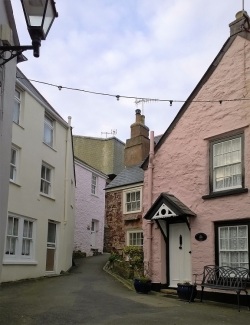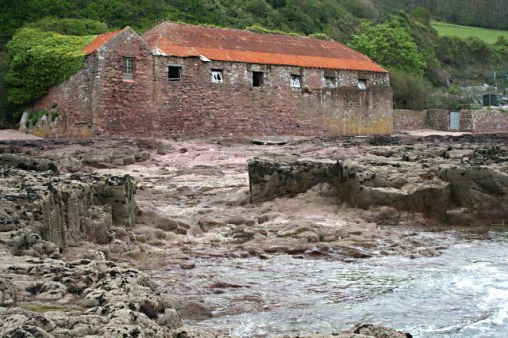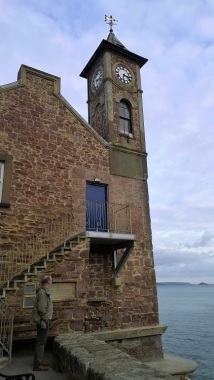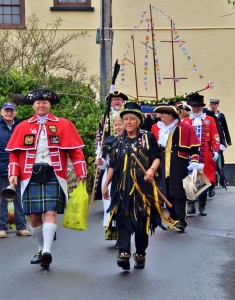The beaches are not the only places to be deserted in Cornwall in the winter. We visited Cawsand and Kingsand, two small villages joined at the hip, which at one time straddled the Cornwall/Devon border. (The border has now been shifted further east and follows the course of the River Tamar.) Had I known of the old border when we were in the villages, I would have looked out for the actual house which perches astride it and proclaims its unique position in its house name.
The villages are sited in a natural cove, and we could see the roofs of Plymouth across the estuary. I found it a trifle unsettling. Modernity and history seemed just a little too close together for comfort. And it felt rather sad to see the Christmas lights still strung across the streets. To be fair, it was still January (albeit the very end of the month), but it made me wonder.

Regardless of those small misgivings, it was a beautiful little place: pastel-coloured houses piled higgledy-piggledy on top of each other along topsy-turvy streets barely wide enough for people, let alone vehicles, to pass through.
Talking of people – we didn’t quite have the village to ourselves but it was more difficult to take photographs including people than not.
We passed a couple of ladies bearing bags of shopping, and a couple more with trailing children in their wake: it was school pick-up time. We saw one or two older couples who looked like we probably did: wanderers enjoying the peace and empty lanes. Though there was also a sense of desolation and lives paused as we passed chairs piled haphazardly and the occasional boarded window.
Essentially the village was quiet. Apart from the various building, renovating and decorating works that were underway. Cawsand was taking advantage of the winter emptiness to get those essential works completed before the tourist season resumes.
Perhaps because of Plymouth in the distance, it was more difficult to imagine the village in centuries past. Nonetheless, there was once a fleet of more than 50 vessels smuggling into Cawsand Bay, and evidence of the old pilchard industry remains on the beach to the east of Kingsand .

Richard Carew, a famous son of the county, High Sheriff and writer of the earliest History of Cornwall (1602), refers to the future king, Henry VII (1457-1509), stopping in Kingsand for a secret tipple. My 17th century English is stretched a little here, but was he going to be ambushed in Plymouth? Those dastardly Devonians if so!
“Kings Sand and Causam Bay ……. The shore is peopled with some dwelling houses, and many Cellers, dearely rented for a short usage, in saving of Pilcherd…..I have heard the Inhabitants thereabouts to report, that the Earl of Richmond (afterwards Henry the seventh) while hee hovered upon the coast, here by stealth refreshed himselfe; but being advertised of streight watch, kept for his surprising at Plymouth, he richly rewarded his hoste, hyed sppedily a shipboord, and escaped happily to a better fortune”

But back to our present: we were intrigued by the boards across many of the doors – and not necessarily those fronting the shoreline. It suggested high seas and flooding – yet to us the bay looked so peaceful.
A quick search online put me right: there were severe storms in 2012 and again, twice, in 2014, all of which caused serious flooding.

The old clock tower, built to commemorate the coronation of George V (in 1911) suffered significant damage in the storms of 2014. A year later it was fully restored. We had no idea, looking at it now, 3 years on. All was calm and quiet. The view from here in the present gives no clue to the drama in its past.
But I’ve wandered away from those wooden flood barriers lying across various doors. Their presence was certainly a clue – to what was already becoming clear to us. A sizable percentage of these houses were empty.
This article advises that of the 63 homes on a main Cawsand street, 36 are second homes and 9 are holiday lets. Only 18% are lived in all year round.
This is a serious problem in many pretty coastal Cornish villages. Properties are snapped up by purchasers from ‘up country’. Property prices in Cornwall are frequently out of the reach of local residents, where wages can be lower than elsewhere and can also be seasonal. Those same property prices though, are cheap compared with prices in London and the home counties. It’s a difficult and delicate dilemma and feelings can run high over it. In the middle of winter the issue is highlighted beyond the financial: how to maintain a vibrant community throughout the year when perhaps only a quarter of its homes are lived in?
I don’t feel it appropriate to stray too far into political or local debates of this nature. We too, are from ‘up country’, and we’re too recently arrived for me to feel competent in discussing how it might feel to experience this situation when you’ve lived here all your life. I can only testify that the seasonal contrasts extend well beyond the weather.
I will say that we have met with nothing but warmth and welcome throughout our first year here. We’ve been surprised by the number of people we’ve met – working people, not retirees – who have moved here from elsewhere in the country, or are local people who moved away and then returned. And we love talking to those who’ve lived here all their lives and are brimming with pride for their heritage. There is something here that speaks to many. What Cornwall lacks in wages and employment prospects, it makes up for in beauty, in passion, pride, history and tradition. Regretfully none of those desirable attributes pay bills or put food on the table but they do add significantly to the quality of life in other ways.
Some years back Cawsand and Kingsand (together with another local village, Millbrook) revived an old Mayday tradition: the Black Prince Flower Boat Procession. A day-long procession culminates in floating the decorated boat out to sea to banish the winter cold and welcome in the spring weather. This takes place on the May Bank Holiday which will fall on its earliest possible date this year: May 1st.

Which brings me full circle and back to my opening argument in the sister post to this one. Winter is not banished here until May 1st. My suggestion then, that winter remains until March departs is really quite tame in comparison.
I hope that this year we will return to Cawsand for the festival. We’ll see the procession for ourselves – and the village, no longer quiet and empty, but vibrant and alive. What a wonderful way to welcome in the sunshine!








Sandra, your photo of the old pilchard shed reminds me of Cannery Row. I think you said you have read this now? Any similar thoughts when you were on the beach?
LikeLiked by 1 person
Well spotted, Sue; it hadn’t occurred to me at all. When we were in Cawsand I hadn’t finished Cannery Row – hadn’t started it in fact. But having so recently finished it, I’m surprised that I didn’t make any connection at all while I’ve been drafting this post. I wonder if that may have been to do with the weather: Cannery Row is synonymous with heat and sunshine for me! (Loved the book, I’ll have more to say on it soon.)
LikeLike
The east coast of Scotland has exactly the same problem with so many houses lying empty in the low holiday season, it’s difficult for real communities to survive. It’s such a shame, the villages look so quaint and lovely in your photos.
LikeLiked by 1 person
Katrina, I can understand people wanting holiday homes in your area as much as down here – and on your much-loved west coast too. It’s really the first time I’ve come up against the reality of the situation, coming as I do, from various counties all within the prosperous south-east corner. I doubt that there’s a solution. Various schemes are being tried – and ways around them manifest immediately.
LikeLike
It’s a pity so many of the houses are unlived in during most of the year. Up here in Scotland we have loads of “incomers” for exactly the same reasons; beautiful scenery combined with relatively low property prices. The result is that huge swathes of the country are underpopulated a lot of the time. On the other hand, lots of incomers actually live here all the time, and they add considerably to the community, both culturally and economically, so there’s good and bad, as usual. The pilchard cellars look incredibly atmospheric – I feel Daphne du Maurier should have used it as a setting…
LikeLiked by 1 person
After this post went live, I was watching a programme which featured beaches in the north-east of England and reflecting on how stunning our coastline really is: Scottish beaches being right up there. So I shouldn’t really be surprised that the same problems can be found up north. And as you say, incomers – like us down here – certainly have a notable contribution to make.
As for Daphne, you’re right: the pilchard cellars would fit perfectly into one of her stories. She missed a chance there! 🙂
LikeLiked by 1 person
Truth be told, the same phenomenon can be seen here in the US, too. Even on the road where we live, on a big lake, most of the homes are owned by people who use them only in summer and many are Canadians, seeking a rural escape from Montreal. And in the small mountain town of Lake Placid (two winter Olympics were held there), it’s well-known that no one who works there can afford to live there. These small towns you feature are beautiful–and those storm photos are incredible!
LikeLiked by 1 person
Well, Kerry, as often, I find myself learning – or more correctly perhaps – having my eyes opened. Living as I used to, in the prosperous south-east (though with nowhere near the means to contemplate acquiring a second home), this is the first time I’ve come face-to-face with this issue. I’ve been aware that it’s an issue of course, but I’ve not seen the ramifications in winter for the communities that are impacted. It stands to reason that it’s a problem throughout most desirable places in the world; I’ve just remained in happy ignorance until recently.
LikeLike
Charming pictures and very informative. I’ve heard of a slightly different twist on this problem of abandoned village communities in Italy or Greece, for example, where the younger generation are so eager to escape and go to the city for opportunities. More than half the houses are empty (and not even weekenders want to buy them), and as the villagers get older and less energetic, the old traditions, crafts and village essentials are dying out.
LikeLiked by 1 person
Yes, another perspective. A problem with no obvious solution, unfortunately.
LikeLike
Oh, I’m sure you’re welcomed. You might be comers-in, but you have rolled your sleeves up and got involved. It was the same for us in France. When people realised we were there for the long-term (we actually thought forever at the time) they appreciated thae fact that we wanted to give as much as take. Deserted communities are a real problem in so many places, and one it’s hard to ovecome. Thanks for the really interesting history lesson too.
LikeLiked by 1 person
This is such a sad state of affairs that affects so many small communities. It’s only to be expected I suppose but I so wish that the situation could be ammeliorated somehow. We (of course) experience this in rural Wales and it’s difficult to comment without, as you say, straying into the realms of politics – which I don’t want to do either! I do hope that somehow, with the proliferation of internet businesses, more people are able to settle permanently in some of these communities and begin to restore livelihoods. Lovely post, Sandra.
LikeLiked by 1 person
Yes, we were talking about that quite recently: the notion of more people establishing themselves in rural communities by creating different work habits and businesses. It’s certainly happening but to what extent I have no idea. We can hope!
LikeLiked by 1 person
Thanks, Sandra, for this interesting and thought-provoking post, and the evocative photos too.
LikeLiked by 1 person
Some of the photos remind me a bit of Mevagissey, where my great aunt lives. Streets that aren’t wide enough for cars to pass.
LikeLiked by 1 person
Yes, there are plenty of narrow streets around here, Emma. Mevagissey is larger than the village I’ve included here, and it’s a lot busier. I imagine it still has some life even in the middle of winter. I’m hoping we’ll get back to Mevagissey this year; we made a very quick trip last summer. I have lots of childhood memories of Mevagissey!
LikeLike
Emma, when we lived for a while in Torquay, we heard the Mevagissy male choir and were so in love with their voices that Hero Husband bought a CD…. wonderful memories
LikeLiked by 1 person
This is my first visit to your blog. That is difficult when most people who buy houses don’t live there, how do you build a vibrant community? My husband and I visited Padstow on May Day years ago, a beautiful area. I live in California.
LikeLiked by 1 person
Hi Terra, thanks for visiting 🙂 Yes, it’s a difficult problem. Padstow is not far from us on the north coast. We’re planning a trip there very soon so hopefully I’ll have some photographs to add here. We live in a beautiful part of the world but then it seems to me from films and photographs that almost all of California is very beautiful too. 🙂
LikeLike
The story of Cawsand and Kingsand reads like a folktale. The quiet beauty of the ‘pastel coloured houses piled higgledy-piggledy on top of each other on topsy turvy’ streets difficult to shoot with people in it, flows straight to the heart through your mellifluous prose. The recent phenomenon of the uptown gentry occupying most of the Cornish villages only to keep it abandoned is disconcerting.
LikeLiked by 1 person
Well ✒ penned👍👌
LikeLike
thank you Eliza 🙂
LikeLike
Yr welcome..😊
LikeLike
wonderful story telling and incredible photos… they make my heart sing and my throat sigh
LikeLiked by 1 person
You’re very kind, Kiki 🙂 I see you’ve visited this part of the world too. It’s very different here at the moment compared to in the winter of course. It’s a long weekend as well – plenty of sunshine and plenty of people!
LikeLike